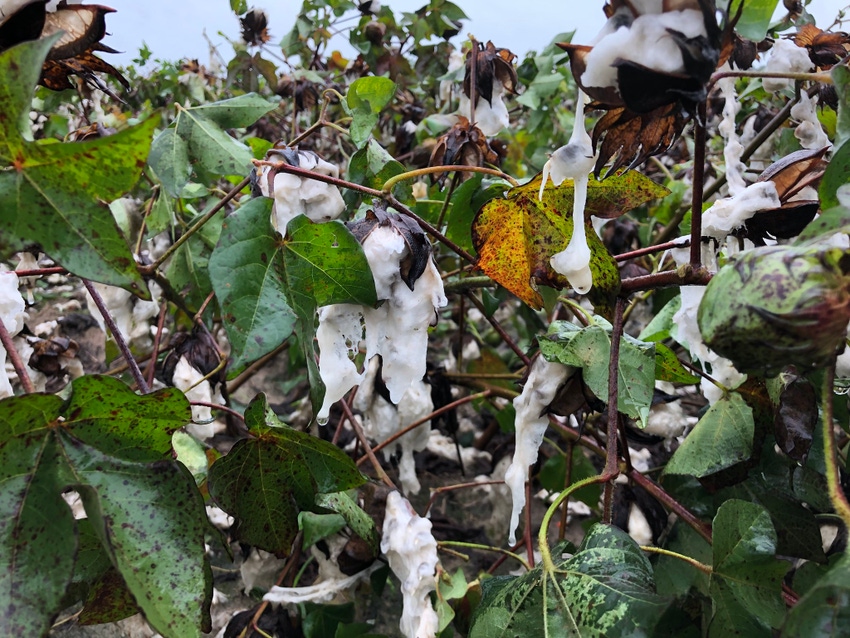September 28, 2018

Hurricane Florence brought historic rainfall to cotton fields across the eastern Carolinas, and other parts of the Southeast have experienced excessive rainfall, too, as harvest begins.
Florence’s magnitude is extreme but wet conditions cause quality and yield losses to some growers somewhere each year. The best remedy for wet cotton fields is a long period of dry weather, and harvesttime months in the Southeast are typically the region's driest, but that doesn’t always happen.
(EDITOR'S NOTE: This story was updated Oct. 1 with information about handling sprouted cotton due to excessive moisture.)
The National Cotton Council has information to help growers facing wet fields preserve quality. The entire article can be read here, but here are a few of the recommendations:
Monitor regrowth on a field-by-field basis
Green leaf from cotton regrowth or weeds can cause problems with harvesting and provide another source of moisture, which can further complicate issues related to seedcotton moisture. Fields may require an additional harvest aid application if regrowth becomes excessive.
Allow seedcotton to dry prior to harvest
If possible, cotton should only be harvested with at least seven to 10 additional days of sun exposure after an extended wet spell. This will allow the germinated cotton seedlings to die and dry as well as allow the non-germinated cottonseed to dry. In most instances, if at least 50% of the cottonseeds are firm, the cotton can be ginned. In terms of color grades, the sunshine may bleach the lint and improve the cotton's color.
Monitor seedcotton moisture/temperature
Producers resuming harvest too soon after a rain event should anticipate seedcotton moisture that may exceed 12%. If excessive moisture is present, seedcotton will begin deteriorating if stored more than 24 hours prior to ginning. Research has shown that germinated cottonseed usually maintains a greater moisture level than normal cottonseed. It is recommended that module temperatures be monitored in at least six locations immediately following module formation and again every 12 hours for at least six days. If temperatures rise more than 20 degrees or reach 120 degrees, immediate ginning is recommended.
Bring dry seedcotton to gins
Growers should take the necessary steps to bring dry seedcotton to the gin, with the understanding that the only thing worse than wet cotton in the field is wet cotton in a module. Growers are strongly encouraged to refer to the publication, "Just Build It" and "Just Tarp It." his publications provide important information on module site selection, module formation as well as tarp selection and application. In case the of creation wet modules can not be avoided, growers are advised to call the ginner ahead of time to be absolutely sure the ginner has the space on his schedule as well as the equipment and capacity to take care of wet seedcotton. Once wet seedcotton is in a module it will deteriorate unless it is ginned immediately. Growers should understand that wet seedcotton is more costly to gin because it requires more heat and slower processing.
Cotton Sprouting
Tyson Raper, University of Tennessee Extension agronomist, in a Sept. 30 post to UTcrop News Blog said:
"Waiting for seedcotton which contains sprouts to dry is different than waiting on damp seedcotton to dry. According to the National Cotton Council, a crop which contains sprouts should be allowed to dry 7 to 10 days. The additional time required to dry seedcotton which has sprouted as compared to normal seedcotton is due to the protected nature of the sprouted seedlings, which are buried deep within each locule. The first step in the germination of a cottonseed is the uptake of water. While our weather has dried the radicle and parts of the shoot out, the cotyledons still contain a considerable amount of water- and these tissues are buried within a seedcoat which is surrounded by a substantial amount of lint (see above).
The cotyledons I inspected today (Sunday, Sept 30) still contained a considerable amount of moisture. Since they are buried deep within the boll, applications of herbicidal defoliants/desiccants will likely only contact a small portion of the seedling. Poor coverage is one reason these applications show mixed results for speeding the drying process.
Should you decide to pick, call your ginner and monitor module temperatures. Placing moist seedcotton within a module will result in the module increasing in temperature. As module temperatures climb, quality degrades rapidly. The only way to halt the process is to gin immediately."
About the Author(s)
You May Also Like






